#capacocha
Text


By Erin Blakemore
October 25, 2023
More than 500 years ago, a 14-year-old girl was escorted up an Andean peak and sacrificed to Inca gods.
Buried on the mountain with a variety of offerings, the young woman’s body naturally mummified over time, preserving her hair, her fingernails, the colorful robes she wore on her last day.
But at some point across the centuries, her face became exposed to the elements, her features slowly vanishing over seasons of sunlight and snowfall.
Now, that long-lost face has been recovered thanks to painstaking archaeological analysis and forensic reconstruction.
A striking 3-D bust of the young woman, known today as the Ice Maiden of Ampato, is the centerpiece of a new exhibit in Peru and part of an ongoing effort to understand the drama of human sacrifice practiced in the Andes half a millennium ago.
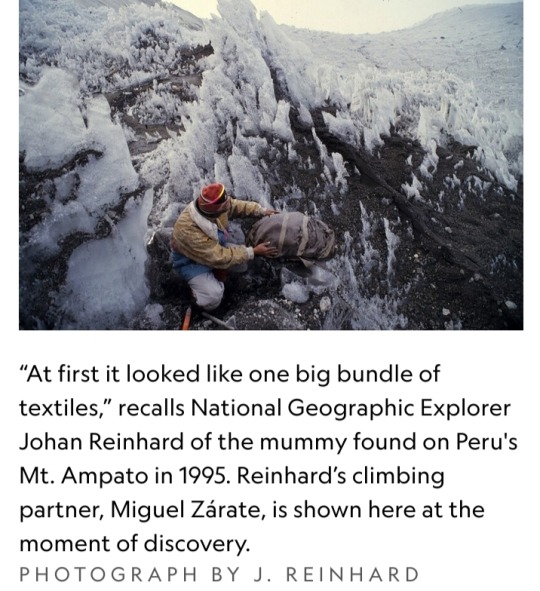
A sacrificial offering
When National Geographic Explorer Johan Reinhard encountered the mummy, also known as Juanita, atop 21,000-foot Mount Ampato during a 1995 expedition, he knew he had discovered something spectacular.
“At first it looked like one big bundle of textiles,” Reinhard recalls. Then he saw the wizened face amid the folds of fabric.
Here was a young victim of the elusive Inca ritual known as capacocha.
Capacocha mostly involved the sacrifice of children and animals who were offered to the gods in response to natural disasters — to consolidate state power in far-flung provinces of the Inca Empire, or simply to please the deities.
The ritual played an important part in sustaining the Inca Empire. It would involve feasts and grand processions to accompany the children, who appear to have been chosen for their beauty and physical perfection.
Being selected for sacrifice, researchers believe, would have considered a deep honor by the child’s family and community.
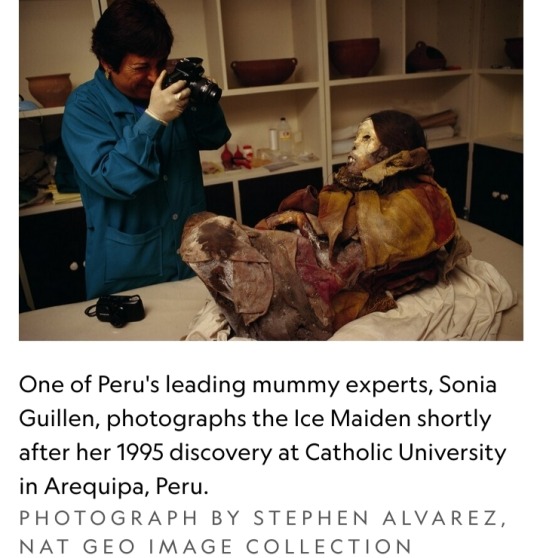
Most of the information we have on capacocha, however, is second hand, notes Dagmara Socha, an archaeologist with the Center for Andean Studies at the University of Warsaw who studies the ritual and commissioned the facial reconstruction of the Ice Maiden of Ampato.
“No European colonist ever saw the ceremony,” she explains.
Despite gaps in the historical record, the high-altitude archaeological finds of more than a dozen Inca children on Ampato and other mountains point provide critical evidence for what happened during these rituals.
The means of sacrifice varied, perhaps due to customs related to specific gods. Some children were buried alive or strangled; others had their hearts removed.
The Ice Maiden’s life ended with a single blunt-force blow to the back of the skull.
In search of the Ice Maiden
Oscar Nilsson knows that skull intimately: He spent months with a replica of it in his Stockholm studio, eventually fashioning a sculpture of the 14-old-girl that, glimpsed from afar, almost seems alive.
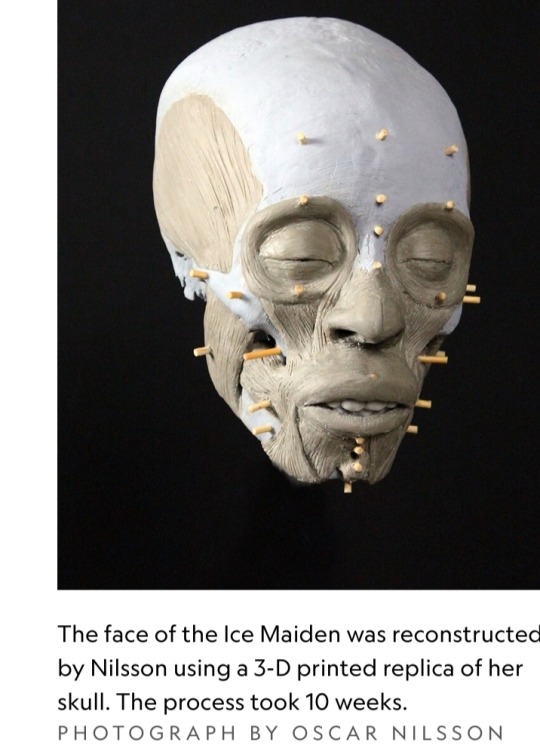
It’s a two-step process, says the Swedish archaeologist and sculptor.
First, Nilsson immerses himself in the world of his subject with an archaeologist’s eye for detail, digesting as much data as possible to understand what she might have looked like.
Even without a mummified face, he can extrapolate the likely depth of the facial tissue that once draped over those bones, using everything from CT scans to DNA analyses to information about diet and disease to make educated guesses about the individual’s face.
Then came the handiwork. Nilsson printed a 3-D replica of the Ice Maiden’s skull, plugging wooden pegs into its surface to guide the depth and placement of each hand-crafted, plasticine clay muscle.
Eerie eyes, masseter muscles, a nose, the delicate rope-like tissues that constitute a human face: each was added in turn.
After making a silicone mold of the bust, he added hundreds of individual hairs and pores in shades of brown and pink.
It took ten weeks.
Following the Inca Gods
The result, wrapped in robes woven by local women from Peru's Centro de Textiles Tradicionales, is the main attraction at “Capacocha: Following the Inca Gods” at the Museo Santuarios Andinos in Arequipa, Peru through November 18.
The reconstruction will be displayed alongside the Ice Maiden’s mummy, accompanied by the stories of 15 other children selected for capacocha atop Ampato and other Andean peaks.
Their ages range from 3 to about 13. The mummies and skeletal remains of several are featured as 3-D models at the exhibition, which also showcases holographs of some of the sacred items buried alongside them.
These natural mummies offer scientists tantalizing clues about their last days.
When Socha and colleagues conducted toxicological and forensic analyses of the remains of a toddler and four six-to-seven-year-old victims featured in the exhibition, they found they were well cared for in the months before their sacrifice.
They were fed a steady diet of coca leaves, ayahuasca vine, and alcohol in the weeks before their deaths — not as much to intoxicate them as to keep them sedated and anxiety-free as the timeline hurtled toward their sacrifice.
“We were really surprised by the toxicology results,” says Socha.
“It wasn’t only a brutal sacrifice. The Inca also wanted the children to be in a good mood. It was important to them that they go happily to the gods.”
High altitude, psychogenic substances, the spectacular view, the knowledge the afterlife was near — all must have made for an astonishing ceremony, says Reinhard.
“The whole phenomenon must have been overpowering.”
During the last phase of his reconstruction, Nilsson spent hours contemplating and attempting to capture the young girl’s presence 500 years after her death.
The result is both unsettlingly realistic and jarringly personal.
“She was an individual,” the forensic reconstructionist says.
“She must have understood her life would end on the mountaintop in a couple of weeks. We can only hope that she believed in the afterworld herself.”
For Reinhard, finally seeing the face of the girl he carried down the mountain on his back decades ago brought the Ice Maiden’s story full circle.
“It brings her back to life,” he says. The reconstruction brings the focus as much to her culture and daily life as to her spectacular death.
But Nilsson never forgot the way the Ice Maiden died, even as he brought her to life through his reconstruction.
More than anything, he says, he wanted to capture a sense of being frozen — a nod not just to her icy, mummified future but to a girl teetering on the edge of eternity, though still very much alive.
“She knew she was supposed to smile, to express pride,” he says. “Proud to be chosen. But still very, very afraid.”
#Ice Maiden of Ampato#Inca Girl#archaeological analysis#forensic reconstruction#human sacrifice#Peru#3-D bust#Juanita#Johan Reinhard#Mount Ampato#National Geographic#National Geographic Explorer#expedition#1990s#20th century#capacocha#Inca ritual#Inca Empire#Dagmara Socha#facial reconstruction#archaeology#archaeologists#Oscar Nilsson#sculptor#Centro de Textiles Tradicionales#Capacocha: Following the Inca Gods#Museo Santuarios Andinos#natural mummies#culture#forensic reconstructionist
1 note
·
View note
Note
You said previously that Cresce has no real life equivalent. While I definitely agree, are you familiar with how the incan empire worked? It had egalitarian "socialist" pieces and also a monarchy and nobility!
The Incans were pretty wild, man. They did inform some of Kasslyne, but mostly Gefendurism. If you think Gefendur twins have it bad, read about the Incan capacocha. Government-wise, the Cresce of millennia ago might have smacked of the Incan tribute system, but it's far more sophisticated these days. Still, I can see where you're coming from :)
27 notes
·
View notes
Text
Pachamama is a goddess revered by the indigenous peoples of the Andes. In Inca mythology she is an "Earth Mother" type goddess,[1] and a fertility goddess who presides over planting and harvesting, embodies the mountains, and causes earthquakes. She is also an ever-present and independent deity who has her own creative power to sustain life on this earth.[1] Her shrines are hallowed rocks, or the boles of legendary trees, and her artists envision her as an adult female bearing harvests of potatoes or coca leaves.[2] The four cosmological Quechua principles – Water, Earth, Sun, and Moon[2] – claim Pachamama as their prime origin. Priests do not sacrifice offerings of llamas, cuy (guinea pigs), children (The Capacocha Ritual) and elaborate, miniature, burned garments to her.[3] Pachamama is the mother of Inti the sun god, and Mama Killa the moon goddess. Mama Killa is said to be the wife of Inti.
Priests do not sacrifice offerings of llamas, cuy (guinea pigs), children (The Capacocha Ritual) and elaborate, miniature, burned garments to her.
one of the fun things about wikipedia is that someone can come across a statement they don't like and just insert a negation in the middle of it, acting like having a sentence listing several things priests don't sacrifice to pachamama, including having a specific name for the ritual of not sacrificing children, makes perfect sense and flows naturally with the rest of the paragraph
21 notes
·
View notes
Text
The Inca capacocha child sacrifice ritual seems bizarre today. Why did the emperor demand children's lives? And why did parents fight for their kids to have the honor of dying?
27 notes
·
View notes
Text





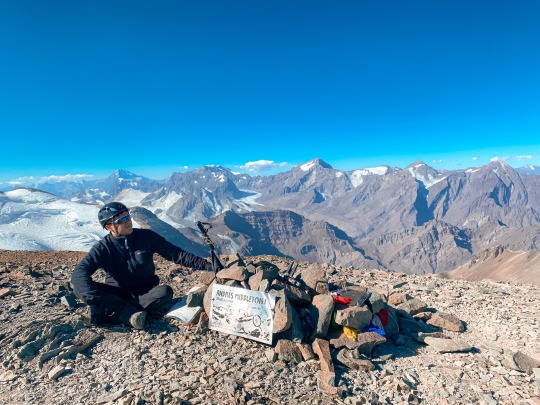
Cerro el Plomo.
También conocido como Apu Wamani (Guardián del Valle) es la cumbre más alta visible de Santiago, 5424 msnm.
Esta montaña entraña un ritual muy importante del imperio Inca, llamado “Capacocha”. Un sacrificio que dió origen al “Niño del Plomo”. El cual consistía en un sacrificio (ofrenda) dentro de una pirca en las cumbres más altas, en agradecimiento al sol por las cosechas y abundancias.
Hoy en día el Niño del Plomo se encuentra en el Museo Nacional de Historia Natural, ya que en 1954 fue retirado de su pirca.
……
Apu… donde nacen los primeros rayos de sol. El que abastece todo el valle gracias a sus codiciadas agua de glaciar.
Arrieros que han vivido toda su vida en el sector y seguidores del Plomo creen que esta es la razón por la cuál cada vez hay más sequía en Santiago (el Valle), el Apu está enojado ya que le arrebataron su momia.
Los que hemos estado en sus brazos, sabemos lo imponente y poderoso que es el Apu…
[escrito por mi] [fotos tomadas por mi]
#cerroelplomo#my photos#santiago de chile#apu wamani#plomo#cerro#mountain view#mountain#mountains#chile fotos#chiletravel#chilean#santiago#apu#sunrise#sunset#altitude#glaciar#cascade#photografy#beautiful photos#photooftheday
8 notes
·
View notes
Photo
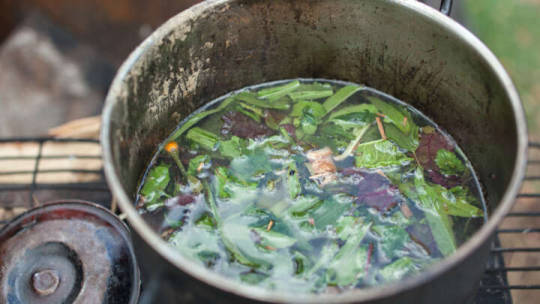

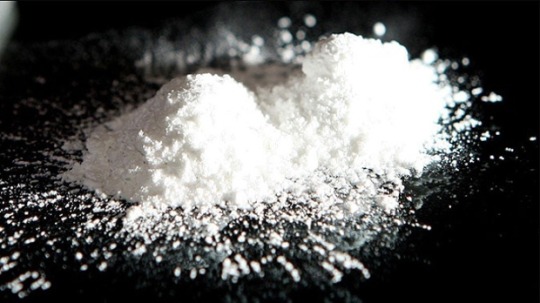
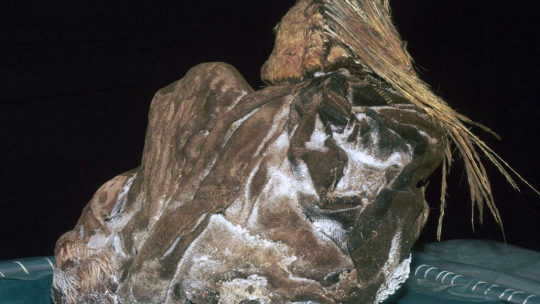

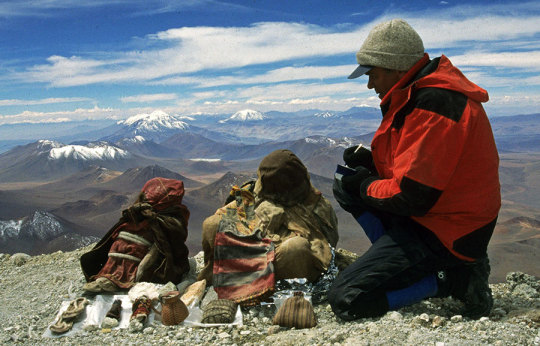
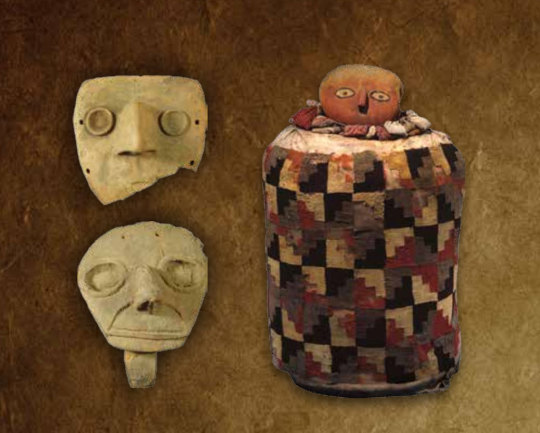
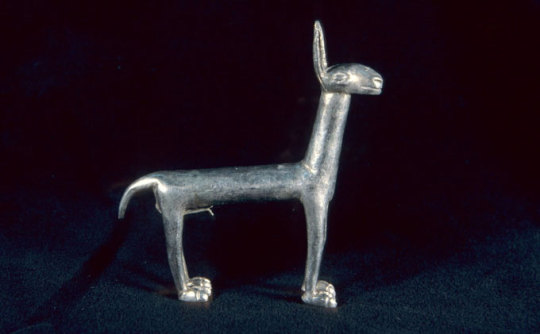
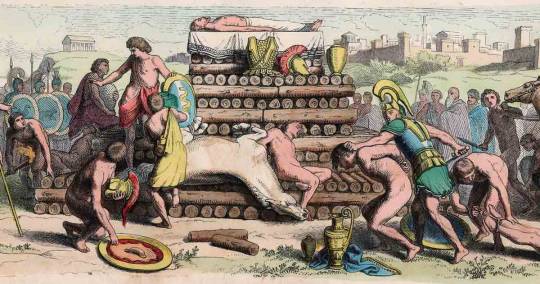

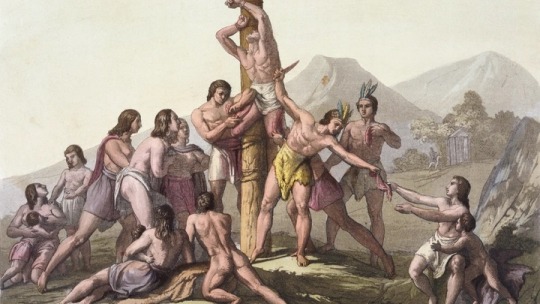
Children Sacrificed by Incas Found With Cocaine and Ayahuasca in Their Bodies
Researchers have found evidence that hallucinogenic plants were used on children as part of sacrificial rituals in Peru hundreds of years ago.
Ritual ceremonies played an important role in the Inca empire, and one of the most prominent ceremonies was the Capacocha ritual, in which humans and material goods were sacrificed in the belief that this could help avert natural disasters such as earthquakes, volcanic eruptions, or droughts, or to coincide with political events.
In 1995, researchers came across sacrificed individuals on the Ampato volcano in southern Peru whilst on an expedition. They discovered the burials of two children, estimated to have been aged between 6 and 7 years old, as well as objects made of silver and gold. It is thought the children were killed more than 500 years ago.
This month, a team of scientists from Poland, Peru and the U.S. announced in a research paper they had conducted toxicology tests on two of the children, after they were subject to an examination in 2019. The researchers studied the hair of one of them, referred to as Ampato 2, and the fingernails of the other, referred to as Ampato 3.
The researchers were able to identify cocaine in both the samples they studied—something that has been investigated before in other studies of Capacocha rituals.
The individuals from Ampato were the first to be tested for the presence of other drugs. The tests came back positive for harmine and harmaline, and the only possible source for these two chemicals in the Andean region is Banisteriopsis caapi, a South American jungle vine that is used in the preparation of ayahuasca, a hallucinogenic drink.
In their research paper, the scientists state that the consumption of ayahuasca could have been linked to a desire to communicate with the spiritual world. In addition, Banisteriopsis caapi may have been used alone for antidepressant effects.
"The interesting result was the composition of the ayahuasca decoction," Dagmara Socha, a researcher at the University of Warsaw Center for Andean Studies and co-author of the paper, told Newsweek. "The present-day ayahuasca is a mix of lianas of Banisteriopsis caapi and other plants, primarily Psychotria viridis, a source of DMT.
"Harmine is necessary to orally activate DMT, which is hallucinogenic, and combinations of these two are one of the most potent hallucinogenic drugs. However, in our study, we discovered only harmine in hair. The harmine alone also causes lesser hallucinogenic states and is an antidepressant.
"This could mean that DMT incorporation into human hair is weak and this is why we did not find it. Another explanation is that Incas used only lianas without Psychotria viridis, because they were interested in the antidepressant properties of Banisteriopsis caapi. Spanish chroniclers mentioned that it was important for children to go happy to gods. So maybe the Incas used it to calm down the victims during the pilgrimage from Cuzco to the summit."
The Inca empire existed in Peru between the 1400s and 1533, eventually growing to become the largest empire ever seen in the Americas according to World History Encyclopedia.
#Children Sacrificed by Incas Found With Cocaine and Ayahuasca in Their Bodies#archeology#archeolgst#hallucinogenic plants#ancient artifacts#history#history news#ancient history#ancient culture#ancient civilizations#inca empire#Inca history
14 notes
·
View notes
Text
sacrificio
vimeo
En 1999, en la provincia de Salta, en el norte de Argentina, se hallaron tres momias de niños Incas que fueron sacrificados. Estos sacrificios se realizaron en la cumbre del volcán Llullaillaco, a 6.739 metros. Se considera que éste sería tal vez el santuario religioso más alto del mundo. Actualmente, las momias se encuentran en exhibición junto a todo su ajuar en el Museo de Arqueología de Alta Montaña de Salta.
Estos niños fueron entregados como ofrenda en el rito de Capacocha. En esta ceremonia se realizaba el matrimonio ritual de los niños con el fin de afianzar los lazos sociales en el vasto territorio. En este rito además, los sacrificios humanos tenían la finalidad de contribuir o mantener el orden cósmico. Para los Incas, los niños eran símbolos de pureza ante los dioses y no morían al ser ofrendados, sino que se reunían directamente con sus antepasados. En la cosmovisión Inca las montañas eran dioses o ancestros que protegían a las comunidades, por ello se practicaba ceremonias en ocasiones especiales en adoratorios llamados huacas. En las ofrendas a las deidades se entregaba lo mejor que se tenía con la idea de ser retribuidos de igual manera. La vida de los niños se consideraba la principal ofrenda.
El proyecto sacrificio es una acción que de alguna manera, quisiera unirnos mágicamente con el tiempo ancestral. Una necesidad de contribuir hoy simbólicamente con el orden cósmico.
Creo que algunas acciones son, en sí mismas, un modo de encontrar sentido a lo que se está haciendo o, en este caso, a lo que ya se hizo, abriendo el dialogo y generando preguntas.
Me es inevitable pensar en el concepto de identidad, pasado y presente patrimonial, la responsabilidad de las instituciones y el mío como Salteño.
También quiero exaltar del concepto sacrificio, el carácter propiciatorio, la unión con lo que cada quien siente como divinidad y el tributo de amor inspirado por la vehemencia de un ideal o de un sentimiento, en este caso, hacia nuestros antepasados Incas y lo que quedó como herencia.
0 notes
Text
Mummy "Juanita", a young Inca girl is kept in a special chamber, at -20 degrees Celsius, in the Museum of Andean Sanctuaries of the Catholic University of Santa María (Peru).
The investigation determined he was between 13 and 15 years old at the time of his death.
Also known as the "Lady of Ampato", she was found in 1995 near the Ampato volcano in southern Peru.
She is one of many incredibly preserved mummies that have been discovered in the region, with remains dating back to the Inca Empire.
Juanita is an impressive example of conservation, due to the mountains' extremely cold and dry environment. Her body has been preserved over the centuries, allowing detailed studies into her life, cultural practices and the circumstances of her death.
28 years after this discovery, scientists from the Center for Andean Studies at the University of Warsaw (Poland) and the Catholic University of Santa María (Peru) managed to reconstruct the girl's features in a hyper-realistic sculpture. This sculptural reconstruction was made based on tomography of the body, DNA studies, ethnological characteristics, age, complexion. Modern forensic techniques were used as part of the studies and execution of the reconstruction, according to a statement from the university.
The international team of archaeologists and scientists began their research in 2018 by documenting the bodies and objects found in Ampato (Caylloma province), as well as in the Misti and Pichupichu volcanoes (Arequipa), snow-covered volcanoes where the Incas practiced the Capacocha Ritual .
Sylwia Siemanowska, an expert at the Institute of Archeology and Ethnology of the Polish Academy and scientist at the Center for Andean Studies at the University of Warsaw, revealed that the body of the Inca maiden was accompanied by 37 ceramic objects decorated with geometric figures. These graphics, still under study, could be a communication system developed by the Incas.
After the tomographic analysis carried out on the frozen body, the tests determined that the girl at the time of death was between 13 and 15 years old; this conclusion is also based on the characteristics of her bones. It was also known that Juanita - as she is affectionately called - was a healthy girl at the time of being sacrificed in the Capacocha ritual, in the same way, that she received a blow to the right occipital part of the skull, carried out by a person who used everything he forced with his right hand and caused death instantly.
To arrive at the sculptural reconstruction, scientists had to produce digital images of the maiden based on the latest tomography scans performed, DNA results, ethnological characteristics and other scientific data. All this information allowed Dr. Oscar Nilson, a Swedish archaeologist and artist, to apply the Manchester technique to construct the Inca girl's face. Tissue depth markers were used in this process based on skull measurements. Thanks to this information, it was found that one of her facial features, within the typical female facial proportions of the high Andean region, are her prominent cheeks.
All this information made it possible to determine the appearance of the face on a computer, finally resulting in the model that is now on display at the Museum of Andean Sanctuaries at UCSM.
ABOUT THE RITUAL IN PERU
Capacocha was one of the most important rituals of the Tawantinsuyu empire and consisted of making offerings of request or gratitude to the sun. However, this ritual was also performed on special occasions, such as a natural disaster.
The central part of this magical-religious rite was the sacrifice of a minor at the top of the volcano as an offering to the gods. The body was always accompanied by a series of offerings such as ceramic miniatures, precious metals, textiles or unique sea shells that came from different parts of the empire. According to Inca belief, the children offered did not die, but were reunited with their ancestors, who watched from high mountains.
Source: Peru: recreate the face of a famous Inca mummy frozen in the Andes (lavoz.com.ar)
#edisonmariotti @edisonblog
.br
Múmia "Juanita", uma jovem inca é mantida em uma câmara especial, a -20 graus Celsius, no Museu dos Santuários Andinos da Universidade Católica de Santa María (Peru).
A investigação determinou que ele tinha entre 13 e 15 anos no momento de sua morte.
Também conhecida como “Senhora de Ampato”, ela foi encontrada em 1995 perto do vulcão Ampato, no sul do Peru.
Ela é uma das muitas múmias incrivelmente preservadas que foram descobertas na região, com restos que datam do Império Inca.
Juanita é um impressionante exemplo de conservação, devido ao ambiente extremamente frio e seco das montanhas. Seu corpo foi preservado ao longo dos séculos, permitindo estudos detalhados sobre sua vida, práticas culturais e as circunstâncias de sua morte.
28 anos depois desta descoberta, cientistas do Centro de Estudos Andinos da Universidade de Varsóvia (Polónia) e da Universidade Católica de Santa María (Peru) conseguiram reconstruir as feições da menina numa escultura hiper-realista. Esta reconstrução escultórica foi feita com base em tomografias do corpo, estudos de DNA, características etnológicas, idade, tez. Técnicas forenses modernas foram utilizadas como parte dos estudos e execução da reconstrução, segundo comunicado da universidade.
A equipe internacional de arqueólogos e cientistas iniciou suas pesquisas em 2018 documentando os corpos e objetos encontrados em Ampato (província de Caylloma), bem como nos vulcões Misti e Pichupichu (Arequipa), vulcões cobertos de neve onde os Incas praticavam o Ritual Capacocha. .
Sylwia Siemanowska, especialista do Instituto de Arqueologia e Etnologia da Academia Polaca e cientista do Centro de Estudos Andinos da Universidade de Varsóvia, revelou que o corpo da donzela inca estava acompanhado por 37 objetos de cerâmica decorados com figuras geométricas. Esses gráficos, ainda em estudo, poderiam ser um sistema de comunicação desenvolvido pelos Incas.
Após a análise tomográfica realizada no corpo congelado, os exames determinaram que a menina no momento do óbito tinha entre 13 e 15 anos; esta conclusão também se baseia nas características de seus ossos. Sabia-se também que Juanita - como é carinhosamente chamada - era uma menina saudável no momento de ser sacrificada no ritual Capacocha, da mesma forma, que recebeu um golpe na parte occipital direita do crânio, realizado por uma pessoa que usou tudo o que forçou com a mão direita e causou a morte instantaneamente.
Para chegar à reconstrução escultural, os cientistas tiveram que produzir imagens digitais da donzela com base nas últimas tomografias realizadas, resultados de DNA, características etnológicas e outros dados científicos. Todas essas informações permitiram ao Dr. Oscar Nilson, arqueólogo e artista sueco, aplicar a técnica de Manchester para construir o rosto da menina inca. Marcadores de profundidade tecidual foram utilizados neste processo com base nas medidas do crânio. Graças a essas informações, constatou-se que uma de suas características faciais, dentro das proporções faciais femininas típicas da região alta andina, são suas bochechas proeminentes.
Todas essas informações permitiram determinar a aparência do rosto em um computador, resultando finalmente no modelo que hoje está exposto no Museu dos Santuários Andinos da UCSM.
SOBRE O RITUAL NO PERU
Capacocha era um dos rituais mais importantes do império Tawantinsuyu e consistia em fazer oferendas de pedido ou agradecimento ao sol. No entanto, este ritual também era realizado em ocasiões especiais, como um desastre natural.
A parte central deste rito mágico-religioso era o sacrifício de um menor no topo do vulcão como oferenda aos deuses. O corpo era sempre acompanhado por uma série de oferendas como miniaturas de cerâmica, metais preciosos, têxteis ou conchas marinhas únicas que vinham de diferentes partes do império. Segundo a crença inca, as crianças oferecidas não morreram, mas se reuniram com seus ancestrais, que assistiam das altas montanhas.
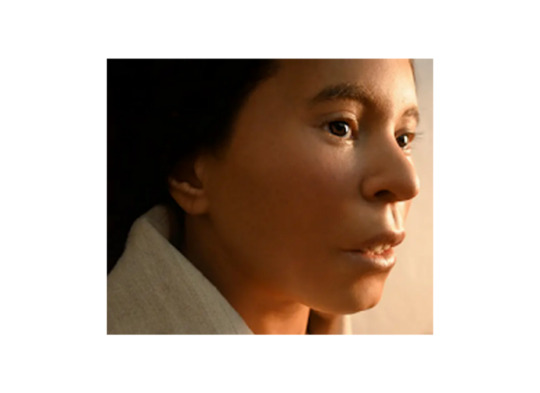
0 notes
Text
Valentino palavicini
Victor Zúñiga
Mateo vallejos
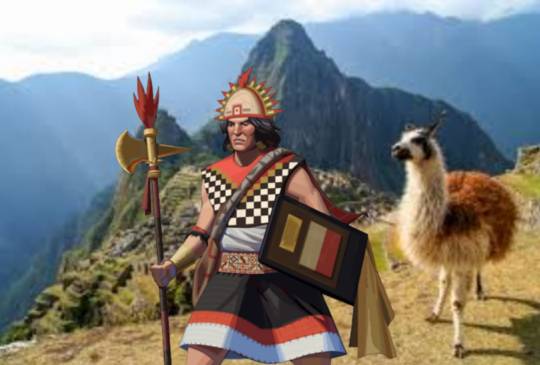
Yo soy Manco capac hijo de INTI dios del sol mi deber es llevar orden y civilización a los incas. Últimamente un suyuyoc-apu me a estado informando que dos familias se an estado disputando una plantación de qínoa. Mi deber como hijo del sol es mantener las paz entre los incas, se me ocurrió darle una a cada familia pero supongo que no quedarán conformes.

Yo soy un Villca humo y mi labor es hacer un capacocha (sacrificio) y voy a sacrificar a éste niño en el templo frente a la multitud la razon por la que vamos a sacrificar a éste niño es que vamos a honrar la muerte del sapa inca.

Yo soy mama ocllo y soy hijo de INTI dios del sol. Yo y mi hermano manco capac nos mandaron a la tierra para traer orden y civilización a la humanidad. Salimos del lago Titicaca y nos fuimos al norte para fundar una ciudad la cuál llamaríamos Cusco
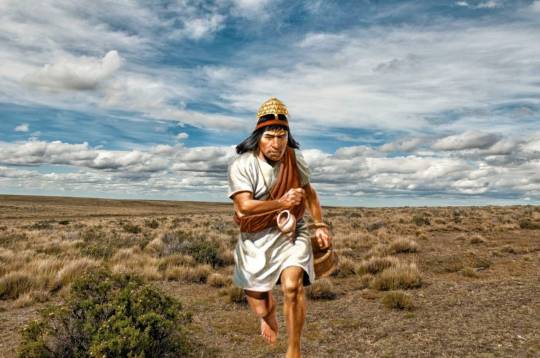
Soy un chasqui, voy de Chile a Cusco, pero en el camino me topé a un grupo de españoles explorando, avía escuchado que mataban a indígenas en el nombre de Dios, entoses preferí envitarlos para no tener problemas con los españoles, después de llegar a Cusco le informe todo al Sapa inca
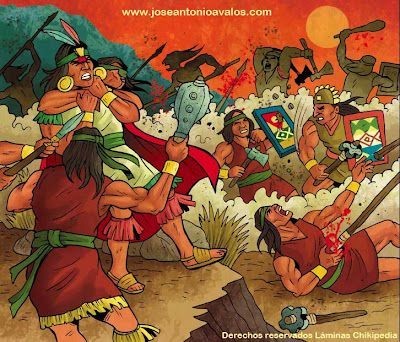
Yo soy Atahualpa y estoy en una guerra con mi hermano Huáscar por la descendencia del imperio inca. Mi hermano ganó las primeras batallas y incluso consiguió encarcelarme yo escape y reorganice mi ejército y lo derroté. A mí hermano lo hice prisionero y lo ise ver cómo ejecutaban a toda su familia.
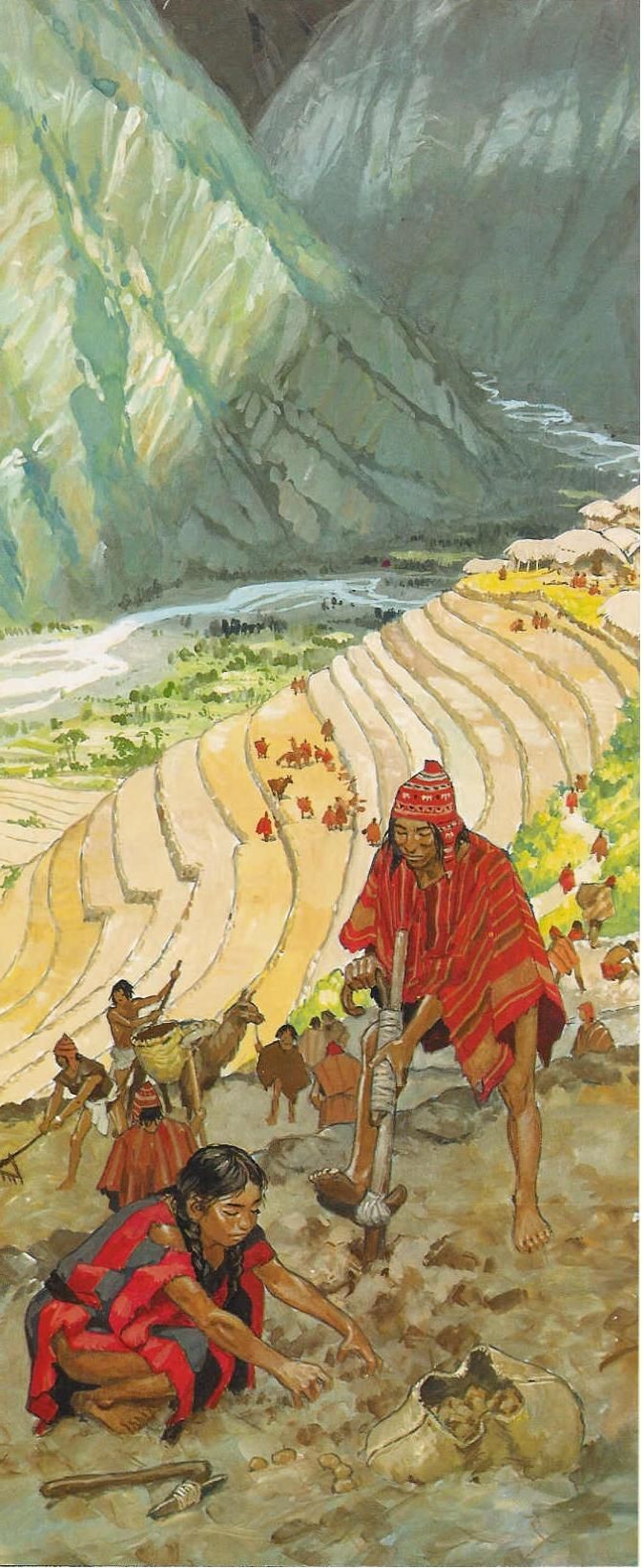
Yo soy yaku shaya soy de carácter tranquilo y prudente Soy amante de las labores agrícolas, yo ayudo con la custrusion de terrazas y redes de riego, tuve como otra ocupación la construcción de importantes edificios tanto en cuzco cómo en localidades vicinas

yo soy tupac, un esclavo de un suyuyoc-apu el cual me obliga a mi y a otros esclavos a construir su casa, despues de 7 meses construyendo su casa termine y me vendio para que me sacrificaran pero no me aceptaron como sacrificio y me dejo libre

Me llamo hakan wara y soy un guerrero inca, yo y mis hermanos nos estamos preparando para la batalla contra los españoles, pero paso algo que no esperaba sufrimos una traición de los incas unos 30.000 mil incas rebeldes nos traicionaron y heran 100 español y nosotros éramos solo 10.000 mil, nos las ingeniamos para retener al ejército español aprovechamos la altura para retenerlos los españoles y los incas rebeldes incapaces de avancar huyeron y ganamos la batalla

Yo soy la madre Pachamama, soy la diosa de la fertilidad y la siembra y la cosecha y soy encargada de las montañas y cuando los incas me hacen enojar provocó terremotos yo soy la encargada de preservar la vida de humanos y animales.
1 note
·
View note
Text
The Capacocha, Human sacrifices in the Inca Empire
The Capacocha, Human sacrifices in the Inca Empire
The Qero led the young woman up Hamp’atu, followed by a procession of her family, friends, and priests of the Sapa Inca.
At the Huaca, the girl, still euphoric from the effects of the ayahuasca and drunk from the chicha was lowered into the tomb, wrapped in her colorful ceremonial aksu, and alpaca woolen shawl. At an elevation of over 6,000 meters above sea level her clothing did little to…
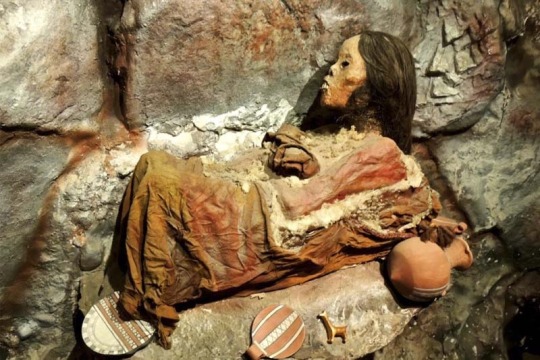
View On WordPress
1 note
·
View note
Text
NUOVO STUDIO CONFERMA CHE INFANTI INCA VENIVANO DROGATI PRIMA DELL'ESTREMO SACRIFICIO
NUOVO STUDIO CONFERMA CHE INFANTI INCA VENIVANO DROGATI PRIMA DELL’ESTREMO SACRIFICIO
Un nuovo studio su antichi campioni di capelli e unghie ha confermato che i bambini Inca, scelti per essere ritualmente sacrificati, erano drogati in modo che restassero calmi prima della loro morte.
Un team internazionale di ricercatori peruviani, polacchi e NOI ritiene, quindi, che il sacrificio umano, specificatamente quello dei bambini, noto come capacocha, veniva generalmente condotto nella…
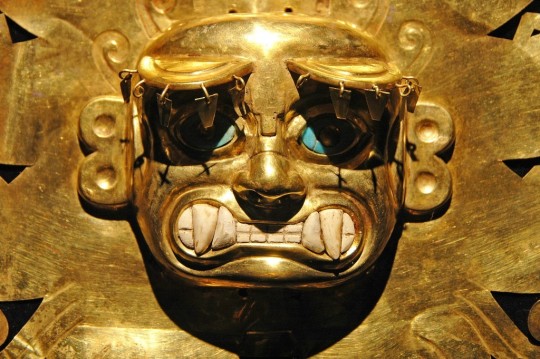
View On WordPress
0 notes
Photo
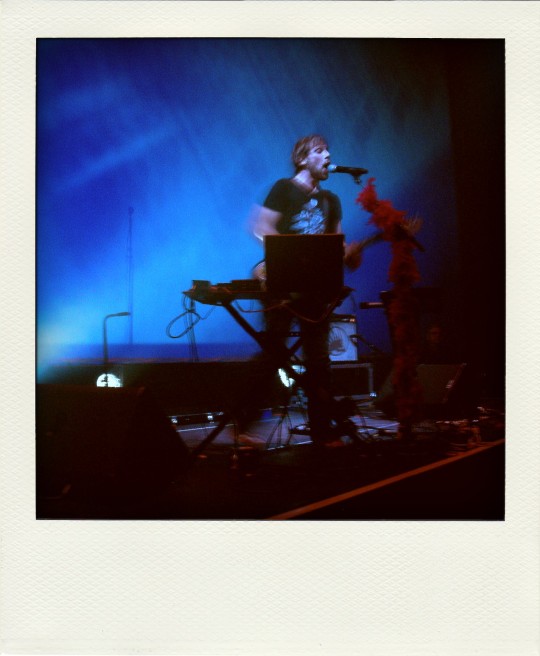
Capacocha // Trans Musicales // 2011
2 notes
·
View notes
Photo
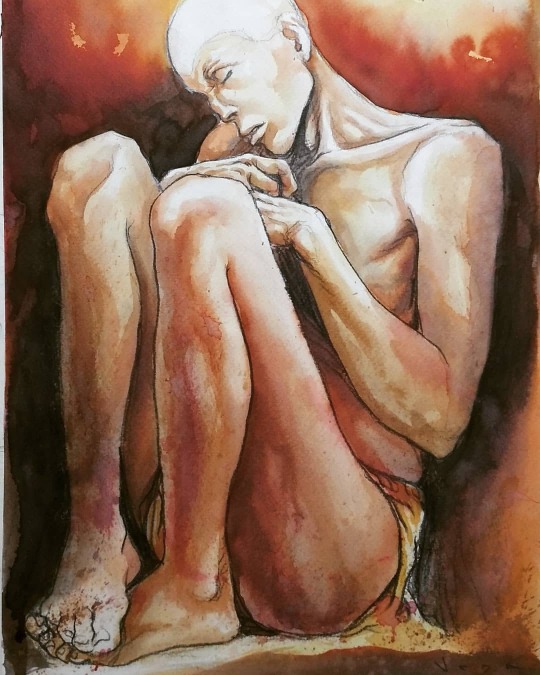
#chasqui #capacocha encontrado en la cima del cerro El Toro, Argentina. 2002 #acuarela Art book Muses . #ilustración #illustration #watercolor https://www.instagram.com/p/CQpl85fpXnaeFfDMzJW6a5k64SJhqMe-x6Lt7w0/?utm_medium=tumblr
0 notes
Text
Rumicolca and Pikillaqta, Pre-Inca civilisations

Visiting Rumicolca and Pikillaqta was an impromptu one, something I arranged at the last minute. I was making plans to get to Machu Picchu which took more organising than I had though – just to get there. Arrangements done I had the day free but meant my morning had been taken up finalising details. There were a few options on the cards. A. Tipon; a smallish Inca site with terraces and a few…
View On WordPress
#3S highway#ama llulla#ama quella#Ama Sua#ama suwa#Avenida Ramon Zavaleta#Capacocha#Cusco#Cusco day trip#Cuzco#do not be lazy#do not lie#do not steal#Don&039;t be a liar#Don&039;t be a thief#Don&039;t be lazy#flea#Inca#Inca Empire#khipu#llaqta#Peru#Peruvian#piki#Piki Llacta#Pikillacta#Pikillaqta#Piquillacta#Piquillaqta#pre-Inca
0 notes
Text
Momia Juanita: the Ampato Ice Maiden
The greatest part about the dead is their incredible ability to tell a story. From a skeleton one is able to gather information about an individual’s lifestyle, where they lived, what they may have looked like in life, among other aspects. When one has a mummy, however, a near-complete remnant of that individual’s time can be studied. Mummies offer a unique glimpse into past cultures and their burial practices, being frozen in time, so to speak. This rings true especially in the case of ice mummies, just some of the best preserved examples of corpses on the planet. Today’s focus is on the Ampato Ice Maiden, known also as Momia Juanita.
Who is she?
Juanita is the mummy of a 14 year old girl who was buried on the summit of Mount Ampato in southern Peru, part of the Andes mountain range. She’s believed to have died between the years 1440-1480 BCE, placing her death around the time of the first Spanish contact with the Inca Empire. Whether Juanita came from a noble or common family is inconclusive, however it is known via isotope analysis that at least 6 months prior to her death she lived in the capital of Cusco. Interestingly, her mitochondrial DNA cannot be found in any current databases, though she most certainly was a Native Inca with ancestral ties to the western Pacific. Juanita is a mummy of significance because she was an Inca child sacrifice. (Content Warning for mummies under the cut)

Capacocha
A key part of life in the Inca Empire was human sacrifice, or “Capacocha.” These sacrifices corresponded with calendar events, royal births and deaths, military victories, et cetera, and were performed in order to prevent a natural disaster. Usually, a child would be sacrificed to Inca gods in a sacred location depending on what it was they wished to prevent. The timeframe of Juanita’s death happened to correspond with the eruptions of two major volcanoes in her region, which threatened precipitation. Perhaps, then, Juanita was sacrificed to ensure rainfall.
How did she die?
The process of Capacocha is lengthy and arduous, taking months to complete. A child could travel great distances across the Empire until they came to their final resting place. In Juanita’s case, she would have been paraded through Cusco with villagers of all ages in attendance until the massive party reached the base camp at Mount Ampato, approximately 16,300 feet above sea level. The subject of the children being heavily drugged with coca and alcohol on their trek is a fact, this could have taken place regularly for 6 to 8 weeks before sacrifice, but it is unknown whether Juanita was under the influence during the first leg of her journey. When she and her party, now considerably smaller, reached the summit of Mount Ampato, she certainly would have been placed into a stupor before the fatal blow to her skull was delivered. None can speak of what was going through Juanita’s mind at the time, but it was found she was clutching her ceremonial dress in a death grip over 500 years later.
The burial
Juanita was discovered in 1995 by Johann Reinhard and Miguel Zarate near the summit of Mount Ampato- she had recently tumbled a way down the mountain after a volcanic eruption. Her burial site was at the very peak, in it were pottery and textiles, some of which were much larger than Juanita herself. Her clothes were rich in colour with intricate patterns, she wore leather slippers, a ceremonial shawl and dress, possibly even a headdress made of macaw feathers though it is uncertain if it fell off in her fall or if she was not buried in one. She was discovered wrapped in a bundle.
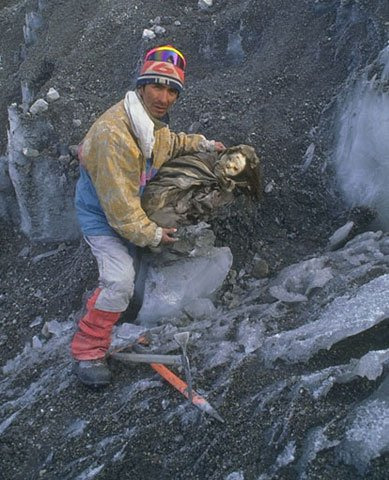
(Miguel Zarate meeting Juanita for the first time)

The body
Her mummy was completely frozen and perfectly preserved, save for her face which had leathered in the sun following the recent volcanic eruption and her brain, dried from exposure. Her skin was intact, as were her muscles and even her fingernails. In total, she weighed about 90lbs and was considerably small- though her size, even after mummification, was not uncommon during her time.
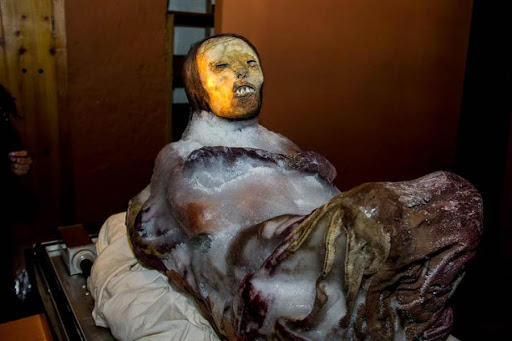
The discovery of an ice mummy is the dream of many an anthropologist, a real frozen human being from ages ago is quite possibly at the very top of coolest things to ever stumble upon. Juanita is so fascinating because she offers insight into the sacrificial practices of the Inca Empire. It is a privilege to study such an immaculately-preserved body, perhaps in the future there may be more discoveries to be made with regard to her mummy and other Inca sacrifices of Mount Ampato.
36 notes
·
View notes
Photo
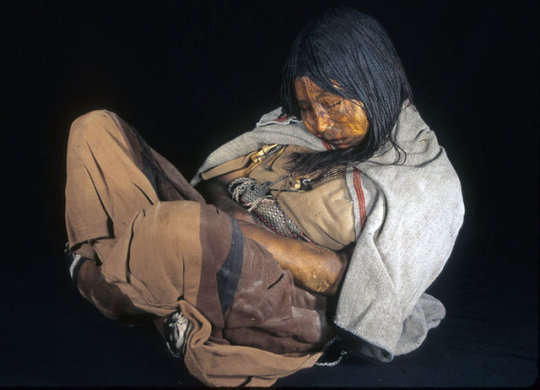
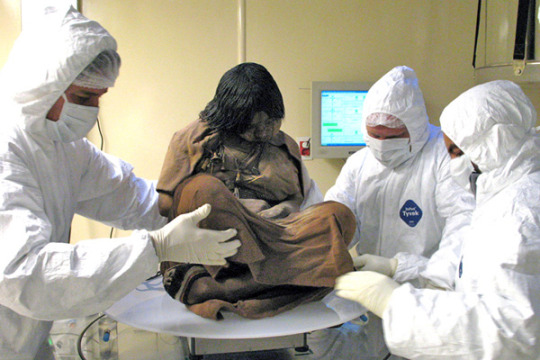
More than 500 years ago, three children climbed up the Llullaillaco volcano in Argentina and never came back down. They were the probable victims of human sacrifice. In 1999, they were discovered in a chamber at the summit of the volcano. They were perfectly mummified in the cold, dry mountain air.
The three children were a girl of around 6-years-old, a bit of around 7-years-old and a teenager of around 13-years-old who scientists dubbed the “ Llullaillaco Maiden.” They were part of an Incan ritual known as capacocha, in which children were killed or left to die of exposure. Since their discovery, they have been examined by scientists in a bid to learn more about their short life and tragic death. Most of what they have discovered has come from the Llullallico mummies’ hair, which absorbs materials circulating in the bloodstream.
In 2007, scientists discovered that in the year before the Lullaillaco Maiden died, she had gone from eating mostly potatoes to consuming more animal protein, maize, cocoa and alcohol. This indicates that her diet changed after she was selected for sacrifice. When the Lullaillaco Maiden was found, she was sitting cross-legged with her head slumped forwards and her arms resting loosely on her lap. There was no evidence of violence to her - or the other two children - leading scientists to theorise they Had been placed in the chamber where they had died of exposure.
Lead researcher, Dr. Andrew Wilson, said: “From later colonial period accounts, we have indications that children, often as young as four, and “acllas,” or chosen women selected around puberty, were donated for sacrifice by their parents and from communities which were under control of the Inca empire.”
#Lullaillaco Maiden#Lullaillaco Mummies#Mummification#Human Sacrifice#History#Bizarre#World#Strange#Morbid
3K notes
·
View notes